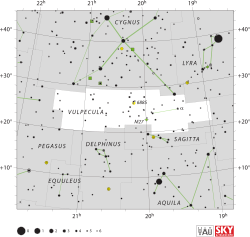14 Vulpeculae is a single,[8] yellow-white hued star in the northern constellation of Vulpecula and proximate to the Dumbbell Nebula (M 27) on the celestial sphere, although actually much closer to the Earth.[9] It is a dim star that is faintly visible to the naked eye with an apparent visual magnitude of 5.68.[2] The distance to 14 Vul, as determined from its annual parallax shift of 18.7753±0.1714,[1] is around 174 light years. It is moving nearer with a heliocentric radial velocity of about −38 km/s,[4] and will make its closest approach in a million years when comes to within about 62 ly (19.04 pc).[2]
| Observation data Epoch J2000 Equinox J2000 | |
|---|---|
| Constellation | Vulpecula |
| Right ascension | 19h 59m 10.5367s[1] |
| Declination | +23° 06′ 04.604″[1] |
| Apparent magnitude (V) | 5.68[2] |
| Characteristics | |
| Spectral type | F1 Vn[3] |
| B−V color index | 0.345±0.004[2] |
| Astrometry | |
| Radial velocity (Rv) | −38.0±3.7[4] km/s |
| Proper motion (μ) | RA: −68.157±0.100[1] mas/yr Dec.: 6.926±0.125[1] mas/yr |
| Parallax (π) | 18.7753 ± 0.1714 mas[1] |
| Distance | 174 ± 2 ly (53.3 ± 0.5 pc) |
| Absolute magnitude (MV) | 2.23[2] |
| Details | |
| Mass | 1.52[5] M☉ |
| Luminosity | 11.09[2] L☉ |
| Surface gravity (log g) | 3.81±0.14[5] cgs |
| Temperature | 6,938±236[5] K |
| Metallicity [Fe/H] | −0.36[4] dex |
| Rotational velocity (v sin i) | 150[6] km/s |
| Age | 1.743[5] Gyr |
| Other designations | |
| Database references | |
| SIMBAD | data |
This is an F-type main-sequence star with a stellar classification of F1 Vn,[3] where the 'n' notation indicates nebulous lines due to rapid rotation. At the estimated age of 1.7[5] billion years old, it is spinning with a projected rotational velocity of 150[6] km/s and has sub-solar metallicity.[4] The star has 1.5[5] times the mass of the Sun and is radiating 11[2] times the Sun's luminosity from its photosphere at an effective temperature of about 6,938 K.[5]
References
edit- ^ a b c d e f Brown, A. G. A.; et al. (Gaia collaboration) (2021). "Gaia Early Data Release 3: Summary of the contents and survey properties". Astronomy & Astrophysics. 649: A1. arXiv:2012.01533. Bibcode:2021A&A...649A...1G. doi:10.1051/0004-6361/202039657. S2CID 227254300. (Erratum: doi:10.1051/0004-6361/202039657e). Gaia EDR3 record for this source at VizieR.
- ^ a b c d e f g Anderson, E.; Francis, Ch. (2012), "XHIP: An extended hipparcos compilation", Astronomy Letters, 38 (5): 331, arXiv:1108.4971, Bibcode:2012AstL...38..331A, doi:10.1134/S1063773712050015, S2CID 119257644.
- ^ a b Abt, Helmut A.; Morrell, Nidia I. (1995), "The Relation between Rotational Velocities and Spectral Peculiarities among A-Type Stars", Astrophysical Journal Supplement, 99: 135, Bibcode:1995ApJS...99..135A, doi:10.1086/192182.
- ^ a b c d Casagrande, L.; et al. (2011), "New constraints on the chemical evolution of the solar neighbourhood and Galactic disc(s). Improved astrophysical parameters for the Geneva-Copenhagen Survey", Astronomy & Astrophysics, 530 (A138): 21, arXiv:1103.4651, Bibcode:2011A&A...530A.138C, doi:10.1051/0004-6361/201016276, S2CID 56118016.
- ^ a b c d e f g David, Trevor J.; Hillenbrand, Lynne A. (2015), "The Ages of Early-Type Stars: Strömgren Photometric Methods Calibrated, Validated, Tested, and Applied to Hosts and Prospective Hosts of Directly Imaged Exoplanets", The Astrophysical Journal, 804 (2): 146, arXiv:1501.03154, Bibcode:2015ApJ...804..146D, doi:10.1088/0004-637X/804/2/146, S2CID 33401607.
- ^ a b Bernacca, P. L.; Perinotto, M. (1970), "A catalogue of stellar rotational velocities", Contributi Osservatorio Astronomico di Padova in Asiago, 239 (1): 1, Bibcode:1970CoAsi.239....1B.
- ^ "14 Vul". SIMBAD. Centre de données astronomiques de Strasbourg. Retrieved 2018-04-13.
- ^ Eggleton, P. P.; Tokovinin, A. A. (September 2008), "A catalogue of multiplicity among bright stellar systems", Monthly Notices of the Royal Astronomical Society, 389 (2): 869–879, arXiv:0806.2878, Bibcode:2008MNRAS.389..869E, doi:10.1111/j.1365-2966.2008.13596.x, S2CID 14878976.
- ^ Benedict, G. Fritz; McArthur, B. E.; Fredrick, L. W.; Harrison, T. E.; et al. (2003), "Astrometry with The Hubble Space Telescope: A Parallax of the Central Star of the Planetary Nebula NGC 6853", Astronomical Journal, 126 (5): 2549–2556, arXiv:astro-ph/0307449, Bibcode:2003AJ....126.2549B, doi:10.1086/378603, S2CID 8562211.
External links
edit- 14 Vulpeculae on WikiSky: DSS2, SDSS, GALEX, IRAS, Hydrogen α, X-Ray, Astrophoto, Sky Map, Articles and images
